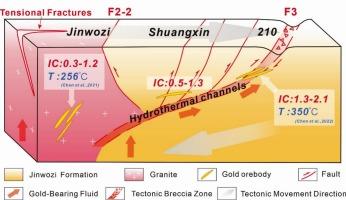Hydrothermal alteration and shortwave infrared (SWIR) spectroscopy exploration of the Jinwozi gold deposit in the Beishan Orogenic Belt, NW China
IF 3.6
2区 地球科学
Q1 GEOLOGY
引用次数: 0
Abstract
The Jinwozi orogenic gold deposit, located in the western Beishan mineralization belt of the Central Asian Orogenic Belt (CAOB), comprises three mining areas: Jinwozi (biotite granite-hosted), Shuangxin (altered sandstone-hosted), and 210 (carbonaceous mylonite-hosted). The paragenesis sequence of mineralization and alteration in three mining areas can be broadly divided into the metamorphic deformation stage, hydrothermal mineralization stage and supergene stage. In the Jinwozi mining area, the hydrothermal stage is further divided into the early silicification-chloritization-pyritization, main mineralization with intensive silicification-pyritization-sericitization, and late carbonation. In contrast, the Shuangxin mining area is characterized by silicification and chloritization as the early phase, while the 210 mining area is dominated by silicification and pyritization. The main mineralization and late phase are similar across all three areas.
By combining petrography and shortwave infrared (SWIR) spectroscopy, alteration zonation in the Jinwozi gold deposit can be delineated as quartz-muscovite ± chlorite zone, quartz-muscovite-chlorite ± epidote zone, and quartz-muscovite-pyrite zone, with the latter being most closely related to mineralization. In all three mining areas, spectral analysis shows that the Al-OH absorption peak position (Pos2200) of white micas (muscovite, illite, phengite and paragonite) proximal to ore bodies are shorter (Pos2200 < 2202.5 nm), whereas the spatial distribution of illite crystallinity (IC) values exhibits inconsistencies. Specifically, the Jinwozi (0.3–1.2) and Shuangxin (0.5–1.3) mining areas both exhibit lower IC values proximal to ore bodies, contrasting with the 210 mining area where higher values (1.3–2.1) occur within proximity. Meanwhile, the IC values show an increasing trend from the Jinwozi (0.3–1.2) to Shuangxin (0.5–1.3), and the 210 mining area (1.3–2.1), suggesting that the 210 mining area could be the hydrothermal center, and the 210 structural fracture zone may serve as the primary hydrothermal channels. Therefore, Pos2200 < 2202.5 nm, Jinwozi mining area IC: 0.3–1.2, Shuangxin mining area IC: 0.5–1.3, 210 mining area IC: 1.3–2.1, can be considered as new exploration indicators for the Jinwozi gold deposit. This study provides practical support for the application of SWIR technology in orogenic gold exploration, offering new scientific evidence and technical guidance for the exploration of the Jinwozi gold deposit and similar deposits in the Beishan Orogenic Belt.

北山造山带金窝子金矿床热液蚀变及短波红外光谱勘探
金窝子造山带金矿床位于中亚造山带北山西段,由金窝子矿区(黑云母花岗岩为主)、双新矿区(蚀变砂岩为主)和210矿区(碳质糜棱岩为主)3个矿区组成。3个矿区的成矿蚀变共生顺序大致可分为变质变形阶段、热液成矿阶段和表生阶段。金窝子矿区的热液阶段又可划分为早期硅化—氯化—黄铁矿化阶段、以硅化—黄铁矿化—绢云母化为主的成矿阶段和晚期碳酸化阶段。双新矿区早期以硅化、绿泥化为主,210矿区以硅化、黄铁矿化为主。3个地区的主成矿期和晚期相似。结合岩石学和短波红外光谱分析,将金窝子金矿蚀变分带圈定为石英-白云母±绿泥石带、石英-白云母-绿泥石±绿帘石带和石英-白云母-黄铁矿带,其中石英-白云母-黄铁矿带与成矿关系最为密切。波谱分析表明,3个矿区靠近矿体的白云母(白云母、伊云母、云母和paragonite)的Al-OH吸收峰位置(Pos2200)较短(Pos2200 <;2202.5 nm),而伊利石结晶度(IC)值的空间分布则不一致。其中,金窝子矿区(0.3 ~ 1.2)和双新矿区(0.5 ~ 1.3)靠近矿体的IC值较低,210矿区靠近矿体的IC值较高(1.3 ~ 2.1)。同时,IC值从金窝子(0.3 ~ 1.2)到双新(0.5 ~ 1.3)、210矿区(1.3 ~ 2.1)呈增加趋势,表明210矿区可能是热液中心,210构造断裂带可能是主要热液通道。因此,Pos2200 <;2202.5 nm,金窝子矿区IC值为0.3 ~ 1.2,双新矿区IC值为0.5 ~ 1.3,210矿区IC值为1.3 ~ 2.1,可视为金窝子金矿新的找矿指标。本研究为SWIR技术在造山带金矿找矿中的应用提供了实践支持,为北山造山带金窝子金矿及类似金矿的找矿提供了新的科学依据和技术指导。
本文章由计算机程序翻译,如有差异,请以英文原文为准。
求助全文
约1分钟内获得全文
求助全文
来源期刊

Ore Geology Reviews
地学-地质学
CiteScore
6.50
自引率
27.30%
发文量
546
审稿时长
22.9 weeks
期刊介绍:
Ore Geology Reviews aims to familiarize all earth scientists with recent advances in a number of interconnected disciplines related to the study of, and search for, ore deposits. The reviews range from brief to longer contributions, but the journal preferentially publishes manuscripts that fill the niche between the commonly shorter journal articles and the comprehensive book coverages, and thus has a special appeal to many authors and readers.
 求助内容:
求助内容: 应助结果提醒方式:
应助结果提醒方式:


